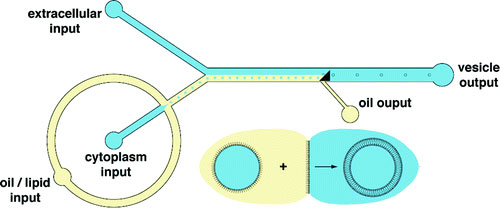| Mar 04, 2011 |
Research scientists create cell assembly line
|
|
(Nanowerk News) Borrowing a page from modern manufacturing, scientists from the Florida campus of The Scripps Research Institute have built a microscopic assembly line that mass produces synthetic cell-like compartments.
|
|
The new computer-controlled system represents a technological leap forward in the race to create the complex membrane structures of biological cells from simple chemical starting materials.
|
|
"Biology is full of synthetic targets that have inspired chemists for more than a century," said Brian Paegel, Scripps Research assistant professor and lead author of a new study published in the Journal of the American Chemical Society ("Stepwise Synthesis of Giant Unilamellar Vesicles on a Microfluidic Assembly Line"). "The lipid membrane assemblies of cells and their organelles pose a daunting challenge to the chemist who wants to synthesize these structures with the same rational approaches used in the preparation of small molecules."
|
 |
| Droplets form in a lipid-containing oil flow and travel to a junction where the confluence of oil and extracellular aqueous media establishes a flow-patterned interface that is both stable and reproducible. A triangular post mediates phase transfer bilayer assembly by deflecting droplets from oil, through the interface, and into the extracellular aqueous phase to yield a continuous stream of unilamellar phospholipid vesicles with uniform and tunable size. The size of the droplet precursor dictates vesicle size, encapsulation of small-molecule cargo is highly efficient, and the single bilayer promotes functional insertion of a bacterial transmembrane pore.
|
|
While most cellular components such as genes or proteins are easily prepared in the laboratory, little has been done to develop a method of synthesizing cell membranes in a uniform, automated way. Current approaches are capricious in nature, yielding complex mixtures of products and inefficient cargo loading into the resultant cell-like structures.
|
|
The new technology transforms the previously difficult synthesis of cell membranes into a controlled process, customizable over a range of cell sizes, and highly efficient in terms of cargo encapsulation.
|
|
The membrane that surrounds all cells, organelles and vesicles – small subcellular compartments – consists of a phospholipid bilayer that serves as a barrier, separating an internal space from the external medium.
|
|
The new process creates a laboratory version of this bilayer that is formed into small, cell-sized compartments.
|
|
How It Works
|
|
"The assembly-line process is simple and, from a chemistry standpoint, mechanistically clear," said Sandro Matosevic, research associate and co-author of the study.
|
|
A microfluidic circuit generates water droplets in lipid-containing oil. The lipid-coated droplets travel down one branch of a Y-shaped circuit and merge with a second water stream at the Y-junction. The combined flows of droplets in oil and water travel in parallel streams toward a triangular guidepost.
|
|
Then, the triangular guide diverts the lipid-coated droplets into the parallel water stream as a wing dam might divert a line of small boats into another part of a river. As the droplets cross the oil-water interface, a second layer of lipids deposits on the droplet, forming a bilayer.
|
|
The end result is a continuous stream of uniformly shaped cell-like compartments.
|
|
The newly created vesicles range from 20 to 70 micrometers in diameter—from about the size of a skin cell to that of a human hair. The entire circuit fits on a glass chip roughly the size of a poker chip.
|
|
The researchers also tested the synthetic bilayers for their ability to house a prototypical membrane protein. The proteins correctly inserted into the synthetic membrane, proving that they resemble membranes found in biological cells.
|
|
"Membranes and compartmentalization are ubiquitous themes in biology," noted Paegel. "We are constructing these synthetic systems to understand why compartmentalized chemistry is a hallmark of life, and how it might be leveraged in therapeutic delivery."
|

